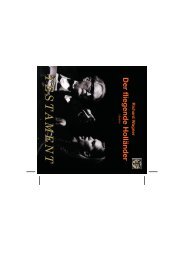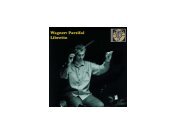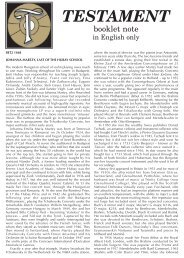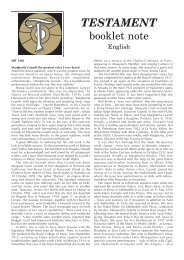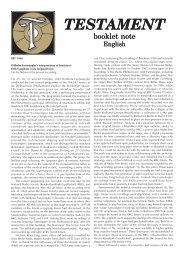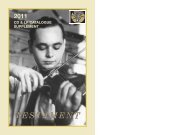You also want an ePaper? Increase the reach of your titles
YUMPU automatically turns print PDFs into web optimized ePapers that Google loves.
on the first night of each production (and at every<br />
subsequent cast change) by Bavarian Radio. No officially<br />
approved recording of a Bayreuth Ring would appear until<br />
1973 when Philips finally issued DG’s (mostly) 1967<br />
recording of a Karl Böhm-led cycle that was supposed to<br />
have been made by EMI, inevitably with few of the 1950s<br />
singers still in the cast.<br />
EMI’s ‘ban’ on the entire Ring was based on the fact that<br />
they had released only Die Walküre Act III (conducted by<br />
Herbert von Karajan at the 1951 Festival) under their<br />
exclusivity contract. Decca now wanted to make a<br />
Rheingold (with Hans Hotter, an EMI artist, as Wotan) and<br />
a Götterdämmerung at the 1954 Festival. They enlisted the<br />
help of Wolfgang Wagner who initiated a correspondence<br />
with Walter Legge in March 1954. Perhaps piqued by<br />
Wolfgang’s description of EMI’s Walküre Act III as a<br />
recording which ‘does not do honour artistically either to<br />
the Festivals or to your firm or to Mr von Karajan’ and to<br />
being reminded that it sold less well than rival Festival<br />
releases, Legge never replied directly. A second letter from<br />
Wolfgang to John Macleod of EMI International, citing the<br />
recent appearance of the pirated Allegro Ring (the<br />
Keilberth cycle from the 1953 Festival) as proof of the<br />
public’s desire for a ‘complete live Ring from Bayreuth’,<br />
restated his case against EMI’s Walküre release in stronger<br />
terms: ‘the issue of this act impetuously demanded by Mr<br />
Legge and Herr von Karajan never had our real approval.<br />
We released it only to placate these gentlemen… it will<br />
never be, for you or for us, an artistic event’. But EMI<br />
dragged its heels, proposing temporary ‘exchanges’ for<br />
Hotter that were never realised – recording a young Georg<br />
Solti in a Glyndebourne Giovanni that summer, or projects<br />
with Rafael Kubelík – and never directly addressing the<br />
question of their rights to the Ring. Meanwhile,<br />
Telefunken’s supremo Herbert Grenzebach gently lobbied<br />
Wolfgang Wagner from Berlin, while taking legal advice<br />
about EMI’s exclusivity clause. Finally Grenzebach advised<br />
London Decca to accept Der fliegende Holländer alone for<br />
1955 and to wait on events for the Ring. Even while<br />
Decca’s team was recording in the Festspielhaus, the<br />
chances of a release for the project were receding and the<br />
start of the Culshaw/Solti/Vienna studio Ring three years<br />
later put an end to it for any immediate future.<br />
The first attempt to record in Bayreuth had been made<br />
as early as July/August 1904 when G & T (the<br />
Gramophone and Typewriter company) sent their<br />
‘recordist’ Will Gaisberg and their ‘studio pianist’, the<br />
conductor Bruno Seidler-Winkler, to work with an<br />
evidently improvised selection of (mostly) Festival singers<br />
in a range of Wagnerian and non-Wagnerian repertoire.<br />
Gaisberg and Winkler set up their equipment in the town’s<br />
<strong>TESTAMENT</strong><br />
booklet note<br />
English<br />
(now demolished) Hotel Sonne, making between 52 and<br />
74 recordings of which only 39 (18 of them of Wagner<br />
material) were released. Recording of lengthier excerpts<br />
from the operas began with the electrical era. In 1927<br />
Columbia defeated their rivals The Gramophone Company<br />
in an auction organised by Siegfried Wagner’s British-born<br />
wife Winifred and made the first recordings actually inside<br />
the Festspielhaus (or, according to some sources, the<br />
restaurant space which doubled as the orchestra rehearsal<br />
room) – excerpts from Parsifal conducted by Carl Muck<br />
and from Rheingold, Walküre and Siegfried under Franz<br />
von Hoesslin. The commercial and sonic success of these<br />
records made Columbia more ambitious and they returned<br />
the following year to make most of Tristan Acts I and II and<br />
a heavily cut version of Act III. A crew from an affiliated<br />
company, Columbia Films, was also in attendance (this<br />
material, including rehearsal excerpts in the theatre and<br />
some film shot at the first day of the Tristan sessions,<br />
appears now to be lost). Another almost complete opera,<br />
Tannhäuser, was recorded in 1930; like the Tristan , it was<br />
conducted by Karl Elmendorff. It bore many of the<br />
hallmarks of the contemporaneous performances prepared<br />
and conducted by Arturo Toscanini in the Festival itself. In<br />
1936 Telefunken became the first German company to<br />
record at Bayreuth, concentrating on the German stars of<br />
that summer’s performances under the baton of the<br />
Festival’s new director of productions Heinz Tietjen –<br />
Franz Völker and Maria Müller in Lohengrin Act III (there<br />
also exists a contemporary and much pirated radio<br />
broadcast of the same cast in this act under Furtwängler),<br />
Völker again in Walküre and the forging songs and Forest<br />
Murmurs of Max Lorenz’s Siegfried. All other recordings<br />
emanating from the Festspielhaus up until its wartime<br />
closure in 1944 derive from the radio broadcasts which<br />
began (but only with isolated acts of one opera per festival)<br />
in 1924.<br />
The rivalry between EMI and Decca at the post-war<br />
reopening of the Festival led to every production in 1951<br />
being recorded at least once, although not all the material<br />
was released. By 1955 the Bayreuth management had tired<br />
of the legal and contractual wrangles that seemed<br />
inevitably bound up with more than one company sharing<br />
the franchise and returned to Winifred Wagner’s pre-war<br />
monopoly policy. Decca alone recorded in 1955 (further<br />
years were stopped by their change of heart about ‘live’<br />
performances and EMI’s exclusion zone on Meistersinger<br />
and the Ring); Philips in 1961 and 1962; DG in 1966-67<br />
and 1970-71. The coming of video (and later DVD) led to<br />
another change of policy – selected productions would<br />
now be both filmed and recorded at specially arranged<br />
sessions before a year’s Festival rehearsals and




